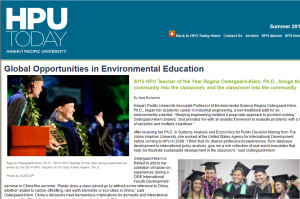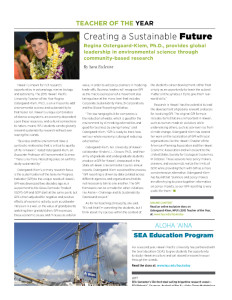2015 HPU Teacher of the Year Regina Ostergaard-Klem, Ph.D., brings the community into the classroom, and the classroom into the community
Hawai‘i Pacific University Associate Professor of Environmental Science Regina Ostergaard-Klem, Ph.D., began her academic career in industrial engineering, a non-traditional path for an environmental scientist. “Studying engineering instilled a pragmatic approach to problem-solving,” Ostergaard-Klem shared, “and provided me with an analytic framework to evaluate problems with a lot of variables and multiple objectives.” After receiving her Ph.D. in Systems Analysis and Economics for Public Decision Making from The Johns Hopkins University, she worked at the United States Agency for International Development before coming to HPU in 2008. “I think that my diverse professional experiences, from database development to international policy analysis, give me a rich collection of real-world anecdotes that help me illustrate sustainable development in the classroom,” said Ostergaard-Klem.
Ostergaard-Klem is thrilled to add to her collection of hands-on experiences during a CIEE International Faculty Development seminar in China this summer. “Rarely does a class period go by without some reference to China, whether related to carbon offsetting, rare earth elements or eco-cities in China,” said Ostergaard-Klem. China’s decisions have tremendous implications for domestic and international sustainability. “Real-life examples gained from traveling through China, directly incorporated into my curriculum, will have an even greater impact on my students.”
Ostergaard-Klem is also preparing her students for the World Conservation Congress (WCC), to be held in Honolulu in 2016. “This is the Olympics of conservation, a gathering of the International Union for Conservation of Nature (IUCN), the oldest and largest international environmental organization. The WCC happens every four years, and it’s never been hosted in the U.S. before,” said Ostergaard-Klem. “We’re expecting between eight and 10 thousand participants.” The IUCN has traditionally been centered on species conservation. However, the organization has become increasingly concerned with balancing ecosystems and community impacts, making this a great moment to present Genuine Progress Indicator (GPI) research, Ostergaard-Klem’s primary focus, to conservation professionals. (GPI, a supplement to GDP, adjusts for negative and positive effects of economic activity.) HPU and the University of Hawai‘i are collaborating to provide Conservation Campus programs, affiliate events providing training and teaching experiences for WCC participants and students from around the world. “My primary goal is to make sure the conference provides tremendous opportunities for enrichment and professional networking for HPU students,” said Ostergaard-Klem. “This is also an opportunity for local leaders from the business and environmental community in Hawaii to engage and share best-practices with their counterparts from all over the world.” Given that the conference will be held on an island, “I hope WCC is an opportunity to further support island partnerships such as that with the President of the Republic of the Marshall Islands and HPU alumnus Christopher Loeak (BA ’79).”
This story originally appeared in the summer 2015 issue of HPU Today.

